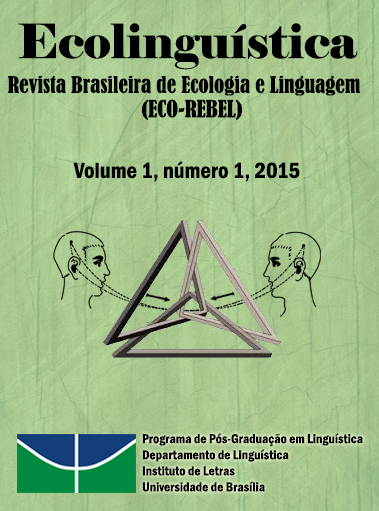Porque **Ecolinguística**
Palavras-chave:
Ciências da linguagem; Visão holística; Ecolinguística.Resumo
Publicado originalmente como Introdução a (Makkai, 1993), este artigo contém grande parte das ideias ecolinguísticas do autor. Basicamente é uma tentativa de mostrar que há outras maneiras de se fazer linguística além da da gramática gerativa, então ‘gerativa transformacional’. O artigo propõe alternativas mais ecológicas para se estudarem os fenômenos da linguagem. Entre as que são mencionadas incluem-se a tagmêmica de Pike, a gramática estratificacional de Sydney Lamb e a gramática sistêmico-funcional de Halliday. No entanto, a alternativa mais consentânea com a nova visão científica seria a ecológica, motivo pelo qual propõe a disciplina ecolinguística, que, mesmo estando in statu nascendi, pode ser um bom ponto de partida para se estudar os fenômenos da linguagem. No entanto, ela não deve ser encarada como um novo paradigma.
Downloads
Referências
ABERCROMBIE, D. Fifty years in phonetics. ForLing 5/2, 1980, p. 169-178.
ALGEO, J. Stratificational grammar. In Makkai; Lockwood (orgs.). Readings in Stratificational linguistics. Al.: The University of Alabama Press, 1973, p. 9-14.
ANTTILA, R. Revelation as linguistic revolution. The First LACUS Forum, 1974, p.171-176.
BEEKMAN, J., Callow, J. Translating the word of God. Grand Rapids, MI.: Zonderman, 1974.
BERGER, P. L.; Luckmann, T. The social construction of reality: A treatise in the sociology of knowledge. Londres: Penguin Press, 1967.
Dinneen, F. P. An introduction to general linguistics. New York: Holt, Rinehart & Winston, 1967.
HALLIDAY, M A K. Language as social semiotic. Londres: Edward Arnold, 1978.
HERRICK, E. M. Sociolinguistic variation: A formal approach. Ala.: The University ofAlabama Press, 1984.
KARÁCSONY, S. Magyar nyelvtan táraslélektani alapon (Hangarian grammar based on social interaction psychology). 1938.
KUHN, T. The structure of scientific revolutions. Chicago: The University of Chicago Press, 1962.
LUCKACS, J. Historical consciousness. New York: Harper & Row, 1968.
MAKKAI, A . Idiom structure in English. Tese de Doutorado, Yale University, 1965.
_______. A pragmo-ecological view of linguistic structure and language universals. Language sciences 27, 1973, p. 9-22.
_______. 1993. Ecolinguistics: ¿Toward a new **paradigm** for the science of language? Londres: Pinter Publishers, 1993.
NIDA, E. A. Towards a science of translating with special reference to principles and procedures involved in Bible translation. Leyden: Brill, 1974.
SHAUMYAN, S. K. Inaugural thought on the philosophy of linguistics, semiotics, and communication as it relates to a New Philosophy of Physics. LP 1, 1983, p. 28-31.
YNGVE, V. H.To be a scientist. The thirteenth LACUS Forum, 1986. p. 5-25.
Downloads
Publicado
Como Citar
Edição
Seção
Licença
Autores que publicam nesta revista concordam com os seguintes termos:
Autores mantêm os direitos autorais e concedem à revista o direito de primeira publicação, sendo o trabalho simultaneamente licenciado sob a Creative Commons Attribution License o que permite o compartilhamento do trabalho com reconhecimento da autoria do trabalho e publicação inicial nesta revista.
Autores têm autorização para assumir contratos adicionais separadamente, para distribuição não exclusiva da versão do trabalho publicada nesta revista (ex.: publicar em repositório institucional ou como capítulo de livro), com reconhecimento de autoria e publicação inicial nesta revista.
Autores têm permissão e são estimulados a publicar e distribuir seu trabalho online (ex.: em repositórios institucionais ou na sua página pessoal) a qualquer ponto antes ou durante o processo editorial, já que isso pode gerar alterações produtivas, bem como aumentar o impacto e a citação do trabalho publicado (Veja O Efeito do Acesso Livre).



3.png)



